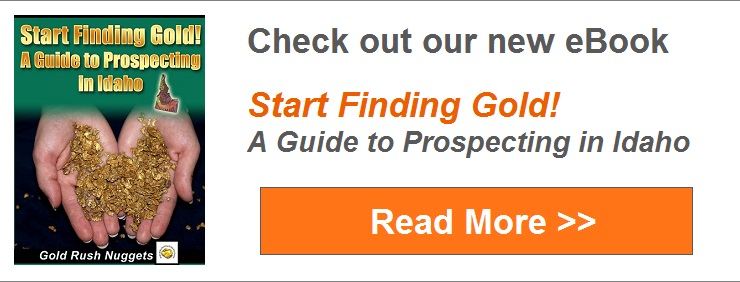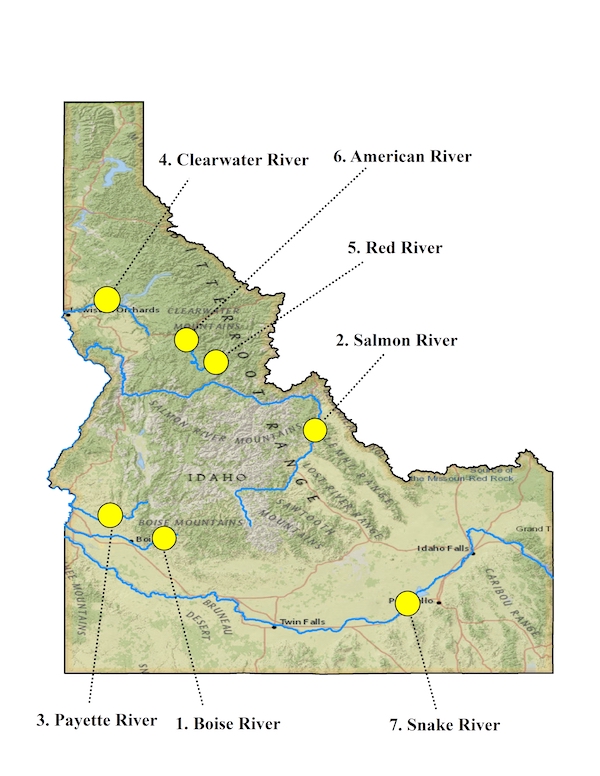
There has been gold found in nearly every part of the state of Idaho. Some of the major rivers have seen a considerable amount of mining over the years.
During the 1860’s, miners were exploring every river and stream in the state in search of rich gold deposits. And they found a lot of gold.
These rivers still have lots of gold today.
1. Boise River Gold
The Boise River drains some very rich gold country. The headwaters start in the Sawtooth National Forest and drain some rugged, mountainous country.
The most noteworthy mining towns include Altanta at the headwaters of the Middle Fork Boise River. Atlanta was primarily a hard rock mining district, but there was a great deal of placer mining that took place in the river downstream of Atlanta as well.
Much of the river has been placer mined downstream of Atlanta. Several abandoned mining towns existed along this part of the river for many years during the late 1800s. A considerable amount of gold was found here.
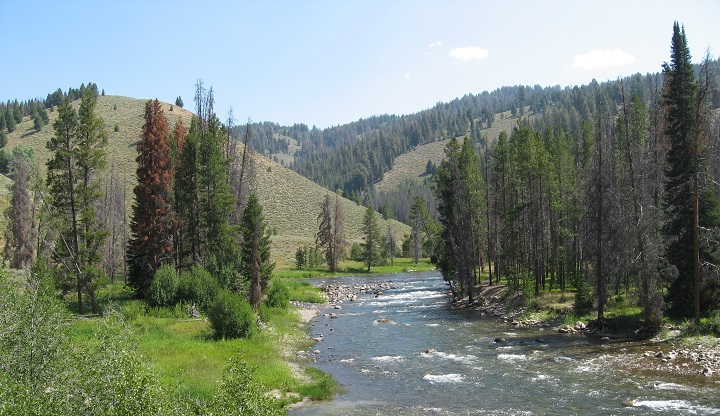
The road that follows the the Middle Fork Boise River from Atlanta downstream to Boise is long and winding, dusty with “washboard” ruts that get worse late in the summer as recreation picks up in the area. Miles and miles of this river are actively claimed, but there are occasionally mining claims that become inactive and open up opportunities for new prospectors.
Over the mountain pass to the south, you will find the headwaters of the South Fork Boise River. The town of Featherville was once a booming mining camp. Above it is Rocky Bar, another old gold mining camp high on the ridge south of Steel Mountain.
You might not know it today, but there was a considerable amount of gold found in this area. Explore the tributaries of the South Fork upstream of Anderson Ranch Reservoir and Paradise Hot Springs. You might be surprised just how widespread the gold is in this area.
2. Salmon River Gold
The Salmon River drains a huge part of central Idaho, with countless gold-bearing tributaries that flow into it. The headwaters start clear up above Redfish Lake at Sawtooth City. As the river flows downstream, it passes through Stanley, Challis, Salmon, through the Frank Church Wilderness, then on the Riggins and Whitebird before eventually draining into the Snake River at Hells Canyon. It spans 425 miles.
You can do some gold panning just about anywhere along the Salmon River and you have a good chance of finding at least some gold. Often it is very fine textured, but there have been some nice gold nuggets recovered in parts of the river as well.
Two rich mining camps named Custer and Bonanza were located on the Yankee Fork, near the Salmon River between Stanley and Challis. The crown jewel of this area today is the Yankee Fork Gold Dredge, a beautifully preserved dredge that once churned up the gravels in search of gold.
There are some long forgotten mining camps throughout the Frank Church River of No Return Wilderness. Prospecting and mining within the wilderness boundary is now strictly forbidden and enforced, but many of the mining areas are “carved out” from the actual wilderness, and there area still some prospecting opportunities. It takes research to ensure you are in an open area.
Large mining operations once recovered lots of gold near Riggins. Some large dredging operations have been productive here over the years. Historically there were miners working all along this river. As you drive along the highway between Riggins and Whitebird, a trained eye will be able to spot the tailing piles left behind from historic miners.
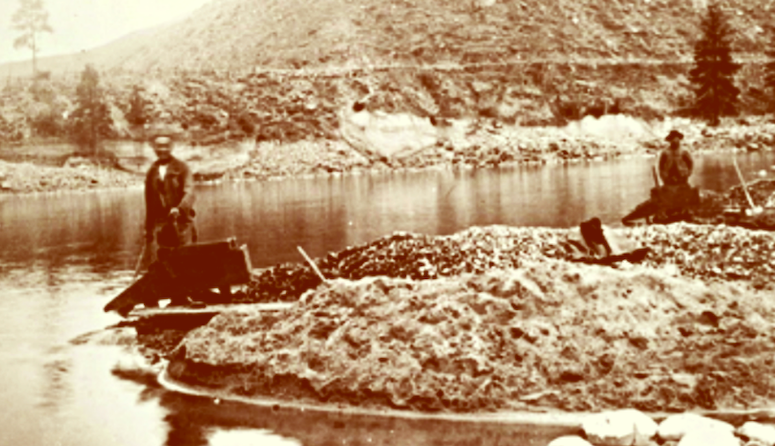
Two Chinese miners working the gravels along the banks of the Salmon River near the mouth of Slate Creek between Riggins and Whitebird. They are using a rocker box to separate fine gold particles from the worthless sand and gravel. Larger rocks are set aside in tailing piles as they dig toward bedrock where the richest gold-bearing gravels are found. The Chinese would often rework the areas after white miners had moved on.
3. Payette River Gold
The Payette River has some parts that have almost no gold present, but if you know where to go there are some very rich placer deposits.
The richest part of the Payette River is near Banks and Garden Valley. Some of the drainages that are part of the famous Boise Basin flow into the South Fork, particularly Alder Creek and tributaries in this area.
There is still very good gold in the South Fork of the Payette River, but parts of the river flow in a very steep canyon and access is very challenging.
4. Clearwater River Gold
The Clearwater River is very rich and a good area to prospect for gold. There are many areas that gold can be found all throughout the river, but certain areas are better than others.
One notable mining town here is Pierce, Idaho. It is the site of Idaho’s first gold discovery and the gold strike was found on a tributary to the Clearwater River.
The South Fork of the Clearwater River is noted for being a very good area to prospect. It starts the small town of Elk City, flowing downstream to the west as it flows on toward Kooskia and into the main stem of the Clearwater River. The stretch from Elk City downstream for 20 or 30 miles is particularly rich.
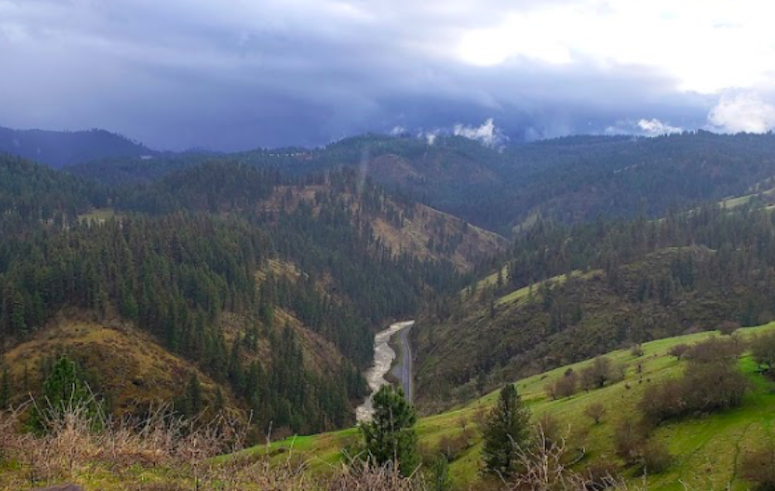
The South Fork of the Clearwater River is one of the richest waters in Idaho. Considerable gold mining took place up around Elk City, then downstream for many miles. This is a very remote area. If you decide to do some prospecting here, make sure you come prepared.
Years ago, I knew a geologist that worked for the BLM that told me about a crew of dredgers who were averaging several ounces of gold per day from the South Fork… this was back in the 70s, when the river hadn’t been mined much using this new method. Unfortunately nowadays, Idaho has been less friendly to mining, and it takes a lot more effort to get the proper permits in place to dredge for gold in Idaho.
5. Red River Gold
This is a tributary to the Clearwater River near the town of Elk City. Gold was first discovered here in 1861, and considerable mining has taken place here. There are miles of the Red River that were mined with bucket line dredges.
Note that bucket dredges are very different from suction dredges. Bucket dredges were actually huge floating boats, set up with a series of cast iron buckets that would dig up the gravel and process it. They recovered lots of gold, and they really tore up the river bottom.
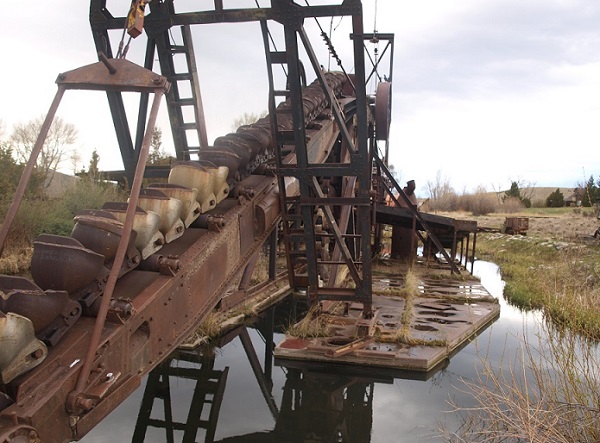
This is a picture of a dredge in Montana, but it is a good example of the type of bucket dredge that was used to process the gravels along the American River, Red River, and sections of the Clearwater River. They were primarily used in the early 1900s, before the start of World War 2. They were large, destructive pieces of equipment that harmed wetlands, but they recovered A LOT of gold. It should be noted that these are very different from the modern suction dredges that are more commonly used today. There are no bucket dredges operating in Idaho today.
6. American River Gold
The American River is another tributary to the Clearwater River located near Elk City. There is very good gold to be found in this river. Historic mining was done all throughout the river system with miles of dredge tailing evident to show for it.
There are lots of hard rock mines in the area around Elk City that feed the placers of the American River.
*Our new eBook Start Finding Gold! A Guide to Prospecting in Idaho is a great resource for Idaho gold prospectors. It covers not only the main rivers and mining camps of Idaho, but also the lesser-known mining districts, small creeks and tributaries, and other forgotten areas were gold can be found throughout Idaho. It covers the entire state, top to bottom, east to west.
7. Snake River Gold
It is interesting to note that the longest river in Idaho, the Snake River, is believed to have more gold than any other river in the entire state of Idaho. Many geologist have surmised this to be true, yet almost no commercial mining has been done along the Snake River.
Historical documents make mention of these fine gold places all throughout the Snake River.
A few areas of note:
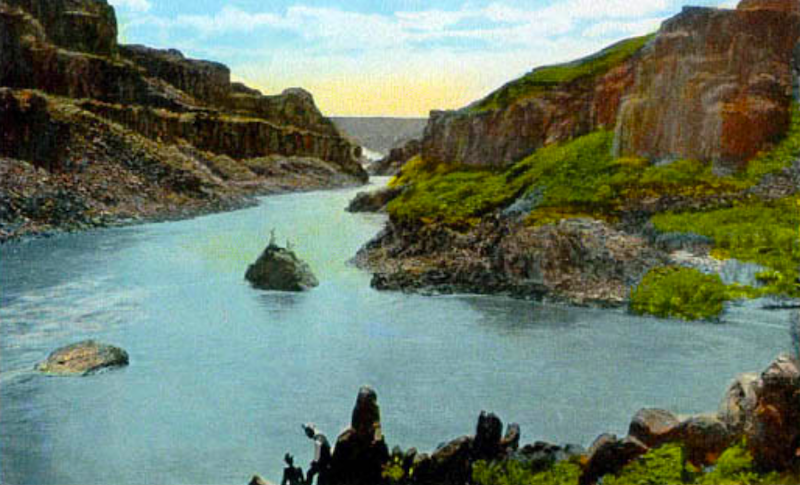
Early miners worked the bars of the Snake River Canyon near below Shoshone Falls. The areas around Blue Lakes and Clear Lakes are noted for their fine gold deposits. Multiple dams and regulated water flows have affected the river significantly from what they once were. Most of the rich bars are covered with water or “silted in” which makes it more difficult for the modern miner to find gold now.
The reason for the limited mining is the fact that gold is extremely fine textured and so widely dispersed that it has been nearly impossible to mine them commercially for a profit. Some of the gravel pits along the Snake River have mined for gold along the Snake, but the gold value was simply a by-product of the existing gravel operations. Mines specifically targeting gold have been short-lived.
Idaho’s Gold Rivers
Prospectors in Idaho are lucky to have so many areas that they can search for gold. Most of the rivers in northern and central Idaho have at least some gold, but the rivers listed above are all well-documented as being very rich.
Keep in mind, some of these Idaho Rivers are several hundred miles long, especially when you consider the different forks and tributaries, and the gold isn’t evenly distributed. There are certain pockets where much more gold is found than others.
Doing research to locate the historic mining towns and specific locations where gold was found by the old-timers will always pay off in more gold.
To take a deep-dive into Idaho’s rich mining history, we recommend you check out our eBook, Start Finding Gold! A Guide to Prospecting in Idaho. It contains hundreds of creeks, rivers, prospects, mines, and other rich areas that are worth exploring. There are literally MILLIONS of ounce of gold still waiting to be recovered in the state of Idaho.
Next: 19 of the Richest Gold Mining Towns in Idaho (Map)




